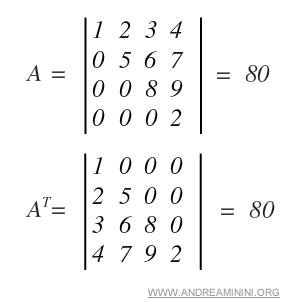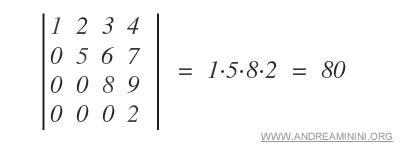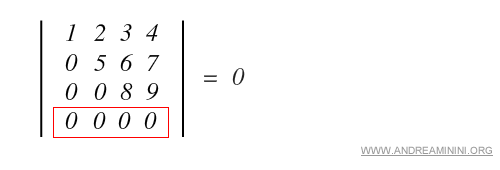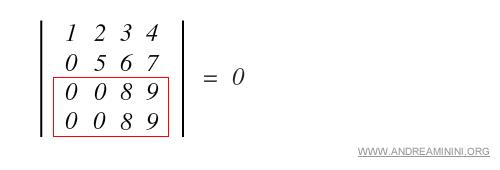Determinant Properties
The determinant of a matrix satisfies the following properties:
- The determinant of a transposed matrix, det(AT), is the same as the determinant of the original matrix, det(A).

Example. In the matrix below, transposing it does not affect the determinant.

- If a matrix is upper or lower triangular, its determinant is simply the product of the elements along the main diagonal.

Example. In these cases, computing the determinant is significantly faster.

- Swapping two rows or two columns flips the sign of the determinant.
Example.

- Multiplying a row or a column by a scalar α scales the determinant by the same factor: det(αA) = α det(A).

Example. Here, the fourth row R4 is multiplied by 2, which also doubles the determinant.

- Adding a multiple of one row to another (or a multiple of one column to another) does not change the determinant.
Example. In this case, the fourth row R4 is updated by adding twice the first row R1.

- The determinant of a matrix is zero in the following cases:
a) A row or a column consists entirely of zeros.

b) Two rows or two columns are identical.

c) Two rows or two columns are proportional.

Note. If a row or column can be expressed as a linear combination of other rows or columns, the matrix is linearly dependent, meaning its determinant is zero.
- The determinant of the product of two matrices satisfies the following identity: det(AB) = det(A) det(B) ( Binet's Theorem ).

- The determinant of the inverse of a matrix is the reciprocal of its determinant: det(A-1) = 1/det(A).

Proof. According to Binet's theorem, the determinant of a product A·B is the product of their determinants: det(A⋅B)=det(A)⋅det(B) Applying this to an invertible matrix A and its inverse A-1: det(A⋅A−1)=det(A−1)⋅det(A) Since multiplying a matrix by its inverse gives the identity matrix, we have: det(A⋅A−1)=det(I) The determinant of the identity matrix is 1, so: det(A)⋅det(A−1)=1 Therefore: det(A−1)=1det(A) This completes the proof.
And so on.
